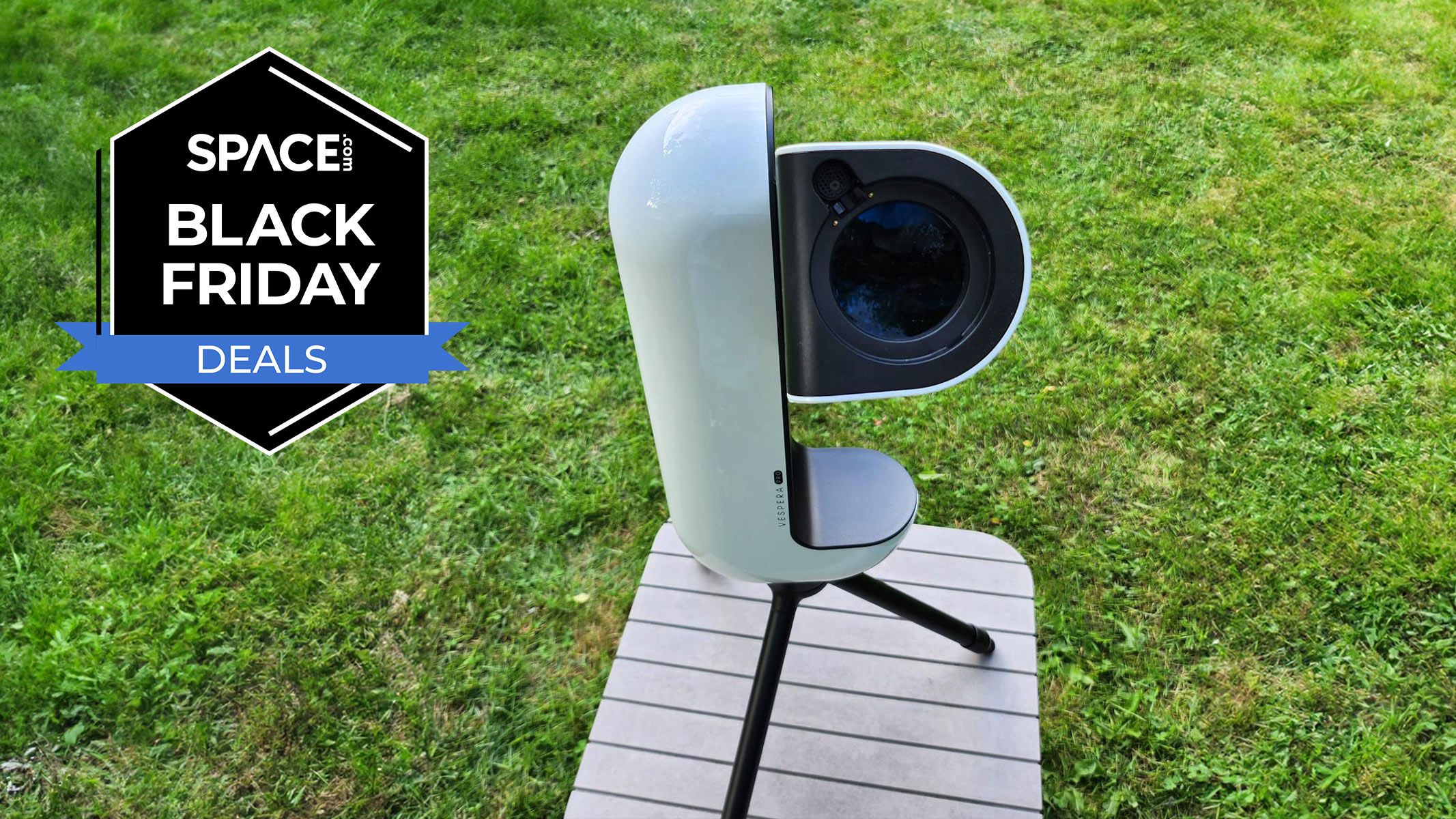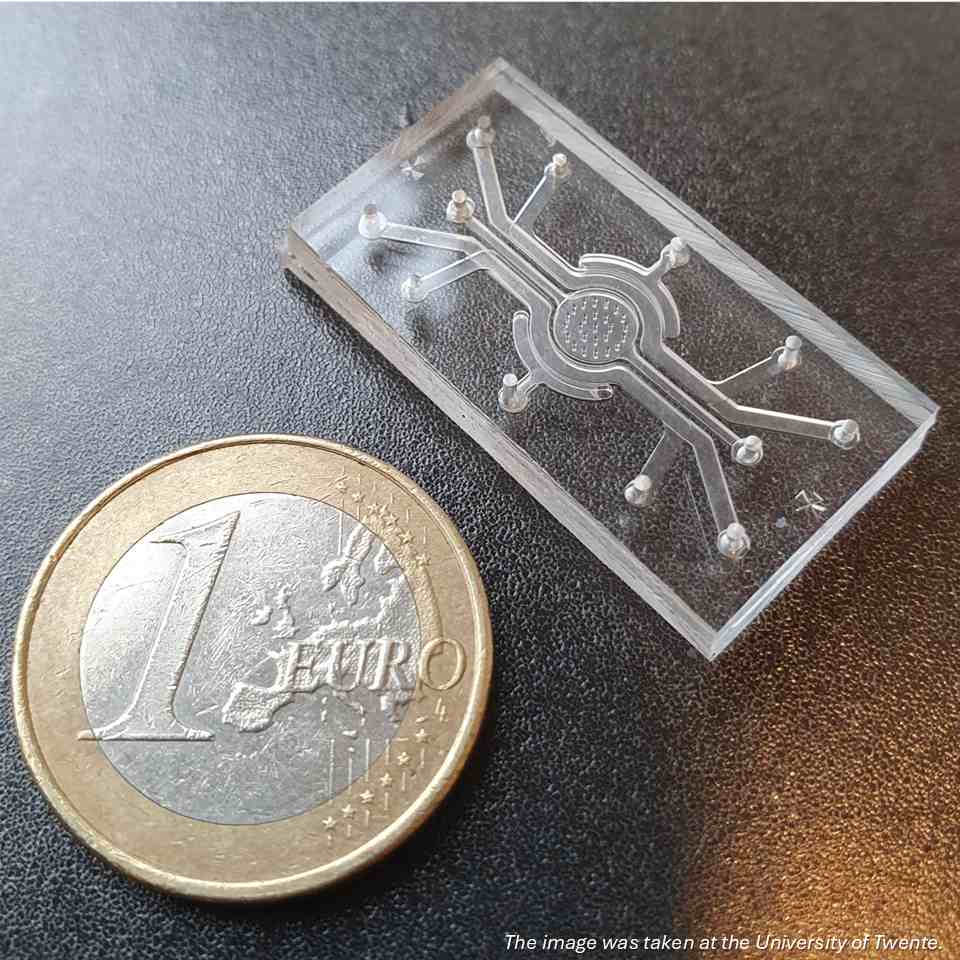Restaurants are temples of aspiration. From sound, scent and ceramics to hand soap and elegant wine glasses, I’ve often wanted to recreate elements of my favourite restaurants at home. I’m unlikely to sous-vide celeriac or triple cook my…
Blog
-

James Webb Space Telescope watches our Milky Way galaxy’s monster black hole fire out a flare
Astronomers have used the James Webb Space Telescope (JWST) to observe flares from Sagittarius A*, the supermassive black hole at the heart of the Milky Way, in a new light. The new modelling of these observations could help scientists get to…
Continue Reading
-
Updated FEI Education Systems for Eventing and Driving/Para Driving
We are pleased to inform you that the updated Education Systems for Eventing and Driving/Para Driving are now published on the relevant discipline pages on inside.fei.org. Please note that the Education Systems for…
Continue Reading
-

Our expert astronomer loved this telescope and now it’s cheaper for Black Friday.
The Vaonis Vespera Pro has been brought to its second-cheapest price by the Black Friday sales. It is a stunning smart telescope that represents the pinnacle of Vaonis’ engineering with a huge 12.5MP sensor and CovalENS technology, allowing…
Continue Reading
-

NIZO and University of Twente launch device tracking how ingredients affect cognition
NIZO and the University of Twente have launched a Gut–Brain Axis on Chip that tracks how nutrients affect brain function, offering food innovators an animal-free testing solution.

The Gut-Brain Axis on Chip. Credit: University…
Continue Reading
-

Capital Thinking: The ‘Picks and Shovels’ in Today’s Data Center Gold Rush
Nicholas V. Beare
During 19th century gold rushes, few prospectors struck it rich, but merchants made real fortunes by selling essential tools for the job—giving rise to the term “pick and shovel businesses.”
Fast-forward, while today’s news headlines heralding the rise of artificial intelligence (AI) focus on chip innovation or software advances, an equally significant story unfolds in the background—massive infrastructure development that enables this technological revolution to even happen.
According to McKinsey research, a staggering $5.2 trillion in data center capacity expansion is required by 2030 to handle AI processing loads, far outstripping the additional $1.5 trillion needed for traditional IT applications.
While it may be too soon to pick long-term winners in the AI gold rush now, an immense investment opportunity lies with the modern ‘pick and shovel’ companies—design firms, contractors and others responsible for creating and powering the vast data centers that underpin AI and make up a group that is steady, essential and often overlooked.

Construction sector firms are 21st century ‘pick and shovel’ companies in AI, providing essential services for that sector’s growth Credit: Getty Images/Rawf8
Complex requirements
Data center construction is not new, but facilities now driven by the scope of AI demands are on an entirely different scale. These are often multiple times larger than legacy sites and consume exponentially more energy—in some cases enough to match the needs of a small city. The scale and technical sophistication of data centers now and the speed at which developers and users want them built is creating demand for companies that train and employ skilled engineers, craft workers. technologists and managers who understand and can execute complex requirements of these projects.
Cooling is a particularly critical challenge. AI processors generate immense heat, prompting the industry to move beyond traditional air cooling and toward liquid and immersion systems. Firms with expertise in providing these advanced solutions are seeing demand accelerate as new data centers come online.
Hyperscalers also seek experts who can find large enough sites to accommodate these facilities, along with access to affordable and abundant power and water supply. This has reshaped the geographic landscape and need for local construction resources and expertise. While Virginia was an early hub for data center development, the buildout has shifted to Southeast and Midwest states such as Texas, Georgia, Louisiana, Ohio and the Dakotas where project siting and permitting have fewer potential hurdles.
Tapping into the tailwind
Technology cycles can be volatile, and AI has experienced bouts of exuberance and uncertainty. But data centers’ significant need for up-front investment, land acquisition, long lead time equipment orders and multiple approvals have created a multi-year backlog of demand—which insulates contractors and suppliers from any short-term swings in sentiment.
This reality has not gone unnoticed by strategic and financial buyers who are increasingly drawn to construction sector firms with significant data center exposure. Stephens recently worked on the sale of a multi-generation, family-owned mechanical contractor. Before the current AI phenomenon, potential acquirers may have viewed the company’s exposure to new construction as a risk. But seeing a meaningful portion of its pipeline in data center work, private equity pounced with bids to purchase the company at a premium multiple to capitalize on this durable, multi-year tailwind.
Public markets are also rewarding firms making the pivot. One civil contractor also recognized the opportunity and acquired a private electrical contractor specializing in semiconductor and data center work. The buyer’s repositioning to gain exposure to one of the fastest-growing construction markets has been a driver of its share-price boom in recent years.
No one knows precisely how the AI ecosystem will evolve over the next decade. There will be winners, losers and inevitable hype cycles. But if the infrastructure to support this transformation is to be built, construction services businesses will remain in high demand to do the building. According to ConstructConnect, US data center starts—both AI and traditional—reached $26.9 billion over the first seven months of 2025. The figure is almost triple the amount for the same period in 2024 and nearly ten times greater than 2023.
Many construction sector companies capitalizing on the current surge in data center construction are privately held, multi-generational businesses with strong regional ties that have learned how to have staying power. Those legacies can make them especially attractive to acquirers and capital partners as the steady ‘pick and shovel’ providers in the new era of AI—but should also help them survive if AI’s current hyper-growth market of hyperscaling falls short of the current rosy predictions.
Nicholas V. Beare is a managing director in the investment banking division of New York City-based financial services firm Stephens. He heads its building and infrastructure group and co-heads its industrials group, also overseeing mergers & acquisitions, management buyouts and exclusive sales and divestitures, among other areas.
Continue Reading
-
India central bank's FX forward book swells for 2nd month, underscoring greater rupee defence – Reuters
- India central bank’s FX forward book swells for 2nd month, underscoring greater rupee defence Reuters
- Indian rupee stalls near record low Business Recorder
- Asia’s Worst-Performing Currency? Modi’s ‘Masterstroke’ or Meltdown? The Internet Is Losing It. indiaherald.com
- #EditorsPicks | One purported argument for the weakening of the rupee was that India’s exports might fare better. But that hasn’t proven to be true. Here’s why 👇 Nalin Mehta | #Rupee #Dollar #Exports — Against the US dollar, the rupee has depreciated from ar LinkedIn
- USD to INR Rupee vs Dollar: Rupee Falls to 89.43 on Strong USD Deccan Herald
Continue Reading
-

Patient Confidentiality and Privacy Among Jordanian Medical Students:
Introduction
The ethical foundation of the physician–patient relationship rests on the principles of privacy and confidentiality. These are not merely procedural concepts but essential conditions for building trust, which enables patients to disclose sensitive information vital for accurate diagnosis and treatment. Historically, this obligation has been central to medical professionalism, exemplified in the Hippocratic Oath, which mandates the safeguarding of patient secrets.1–4
Although often used interchangeably, privacy refers to a patient’s right to control access to personal health information, while confidentiality concerns the provider’s ethical and legal duty to protect that information from unauthorized disclosure.5,6 Adhering to both principles is imperative for ethical practice; violations can undermine patient trust, damage care quality, and result in legal and reputational consequences.
Modern healthcare environments, shaped by digital records and interconnected systems, amplify the risks of confidentiality breaches. While regulations such as HIPAA in the United States and GDPR in Europe provide legal protections, cultural and systemic variations influence implementation.7–10 In Jordan and other Middle Eastern societies, family-centered cultural norms and collective decision-making traditions may influence how privacy and confidentiality are interpreted in medical encounters.11–17 A regional survey also revealed insufficient physician knowledge of privacy standards, despite citing undergraduate training as their main source.18 Physicians and trainees sometimes face ethical tension between maintaining patient autonomy and responding to family expectations for information sharing, particularly when relatives are deeply involved in treatment decisions. Recognizing these sociocultural influences is essential to understanding how medical students in Jordan perceive and apply confidentiality principles within their clinical and educational environments.
Medical education plays a pivotal role in shaping ethical competence. However, studies from Saudi Arabia and Pakistan reveal that medical students often lack formal ethics training and struggle to apply confidentiality principles in complex settings.19–21
Western studies, while showing higher knowledge levels, also report behavioral lapses, for example, chart access without consent in Spain and policy violations among US students.22,23 These disparities underscore the influence of curriculum design and cultural context.
In Jordan, limited research has specifically examined medical students’ understanding and practices related to patient confidentiality and privacy. As the healthcare landscape evolves, there is a pressing need to assess how future physicians are prepared to uphold patient privacy. Although this study was conducted at a single institution, the participating medical school follows the national medical curriculum and accreditation standards, admits students from across Jordan, and is the second largest medical school in the country, making it broadly representative of undergraduate medical education in Jordan. Students in the 4th to 6th years were selected because they are engaged in clinical rotations and patient interactions where confidentiality issues are encountered directly, making them best positioned to provide informed perspectives on ethical knowledge and practice. This study addresses the knowledge-practice gap by evaluating the knowledge and self-reported practices of Jordanian medical students regarding patient confidentiality and privacy, with attention to demographic variables that may inform targeted ethics education.
Materials and Methods
A cross-sectional study was conducted among undergraduate medical students from a Jordanian medical school, aiming to assess their knowledge and self-reported practices regarding patient confidentiality and privacy, and to examine demographic and academic predictors of these practices. The study population comprised undergraduate medical students from one Jordanian medical school, selected to reflect typical training experiences in the region.
Sample and Participants
A convenience sampling approach was used, as all accessible medical students from the 4th–6th years of study were invited to participate through class WhatsApp groups. Participation was voluntary and anonymous, and informed consent was obtained electronically before accessing the questionnaire. Only currently enrolled medical students in the specified academic years were eligible to participate.
The required sample size was estimated using the formula for estimating a mean with a specified precision:
where Z is the standard normal value corresponding to a 95% confidence level (1.96), σ is the estimated population standard deviation of practice scores (assumed = 0.6 based on similar prior studies), and d is the acceptable margin of error (0.07). The calculated minimum sample size was approximately 282 participants, which was exceeded by the final number of valid responses (n = 297).
Study Tools
Data were collected using a structured, self-administered questionnaire that was divided into two main sections. The first section collected demographic information, including the participant’s age group (categorized as 20–24 years and 25–29 years), sex (male/female), and current academic year level (4th, 5th, or 6th year).
The second section consisted of 17 questions designed to evaluate students’ knowledge and self-reported practices concerning patient confidentiality and privacy. Responses to these questions were measured using a 5-point Likert scale, ranging from 1 (Strongly Disagree) to 5 (Strongly Agree).
Knowledge Domain
This domain included 10 questions (1, 2, 3, 4, 5, 6, 7, 8, 9, 10) assessing students’ understanding of the principles of confidentiality, legal implications of breaches, specific scenarios requiring consent (eg, disclosure to third parties, parents of adult patients, employers), and the importance of confidentiality for patient disclosure.
Practice Domain
This domain consisted of 7 questions (11, 12, 13, 14, 15, 16, 17) evaluating students’ self-reported behaviors related to maintaining confidentiality in clinical settings, for example, documenting information, discussing cases in public areas, handling phone calls, allowing non-medical personnel access, and dealing cautiously with sensitive patient information.
Reverse Scoring
To ensure that higher scores consistently reflect better knowledge or better practices, specific negatively worded questions were reverse-scored (original score subtracted from 6, assuming a 1–5 scale). The questions reverse-scored were: Q7 (knowledge domain) and Q12, Q13, Q14, Q16, Q17 (practice domain).
Domain Scores
For each participant, mean scores were calculated for the knowledge and practice domains by averaging the responses (on the 1–5 Likert scale, after reverse-scoring where applicable) to the questions within each respective domain. The domain scores were considered as the primary outcome variables for bivariate and multivariate analyses. Higher scores indicate better knowledge or better self-reported practices.
The questionnaire was adapted from previously validated instruments assessing medical students’ knowledge and practices regarding patient confidentiality and privacy.18,24 To ensure contextual relevance for Jordan, the items were reviewed by three faculty members with expertise in medical ethics and medical education, who evaluated content clarity, cultural appropriateness, and face validity. Internal consistency was reassessed in the current sample using Cronbach’s alpha. The knowledge domain showed moderate reliability (α = 0.624; 95% CI 0.557–0.685), while the practice domain demonstrated good reliability (α = 0.767; 95% CI 0.725–0.806), indicating acceptable to good internal consistency for the scales used in subsequent analyses.
Data Collection
Data was collected using an electronic survey hosted on a secure Google Forms platform. The survey link was distributed via WhatsApp to accessible groups comprising 570 students. A total of 300 responses were received; three were excluded due to incomplete data, resulting in 297 valid responses for analysis. Completing the survey required approximately 8–10 minutes, and the data collection process was conducted over a four-week period, between November 15, 2024 and December 12, 2024.
Statistical Analysis
All statistical analyses were performed using SPSS version 23. The internal consistency reliability of the questions within each revised domain (knowledge and practice, using reverse-scored questions where applicable) was assessed using Cronbach’s alpha coefficient. Confidence intervals (95%) for the alpha values were also calculated. Categorical variables (age group, sex, year level) were presented as frequencies and percentages. For individual survey questions and the calculated domain scores, descriptive statistics including means and standard deviations (SD) were computed. Frequency distributions (percentages) for each response option were also recorded for the 17 questions.
Independent samples t-tests were used to compare the mean knowledge and practice scores between male and female students. One-way Analysis of Variance (ANOVA) was used to compare the mean domain scores across the different academic year levels and age groups. Post-hoc pairwise comparisons (Tukey Honestly Significant Difference, HSD) test was used to identify which specific groups differed significantly when a significant difference was found with ANOVA (p < 0.05). Multiple linear regression analyses were conducted to examine the simultaneous influence of demographic factors and knowledge scores on practice scores. Two separate regression models were built: 1. knowledge score as the dependent variable, with age group, sex, and year level as categorical predictor variables, and 2. practice score as the dependent variable, with knowledge score, age group, sex, and year level included as predictor variables. This model assessed the contribution of knowledge and demographics to self-reported practices. A p-value of less than 0.05 was considered statistically significant for all inferential tests.
The study was conducted in accordance with the Declaration of Helsinki, and the protocol received ethical approval from the Institutional Review Board at the Jordan University of Science and Technology (no. 25/176/2024). All participants consented to participate anonymously and voluntarily by ticking a statement before filling the questionnaire.
Results
Demographic Characteristics
A total of 297 medical students completed the survey. The vast majority of participants (97.3%, n=289) were in the 20–24 age group, and more than half (53.9%, n=160) were females. Regarding academic progression, half of the respondents (50.2%, n=149) were in their 5th year of medical school, while 29.6% (n=88) were in their 4th year, and 20.2% (n=60) were in their 6th year. Table 1 shows the demographic characteristics of participants.

Table 1 Demographic Characteristics of Participants. (n=297)
Descriptive Statistics for Survey Questions
Tables 2 and 3 present the questionnaire items separately for the two domains. Table 2 shows the frequency distribution and descriptive statistics of knowledge-domain items, while Table 3 shows the corresponding results for self-reported practice-domain items. Reverse-scoring was applied where appropriate in both domains. For the 10-item knowledge domain, the highest mean scores (indicating better knowledge) were observed for questions related to fundamental principles, such as “When reporting a case in a medical journal, do not disclose patients’ identity” (Mean=4.60, SD=0.58) and “Medical privacy is an implied term of contract between doctor and patient” (Mean=4.53, SD=0.53). The reverse-scored item Q7 (“In case of minor patients, disclosing the findings to parents or guardians constitutes a violation of confidentiality”) had a mean of 3.87 (SD=0.98), indicating that students generally disagreed with this incorrect statement, reflecting correct knowledge.

Table 2 Frequency Distribution and Descriptive Statistics of Knowledge-Domain Items (n = 297)

Table 3 Frequency Distribution and Descriptive Statistics of Practice-Domain Items (n = 297)
In the 7-item practice domain, the highest mean scores were for “I handle the information of patients with sensitive diseases (mental illnesses, sexually transmitted diseases, etc.) with more caution” (Mean=4.61, SD=0.56) and “Make sure that information taken from the patient is documented with complete confidentiality” (Mean=4.48, SD=0.54). The reverse-scored questions reflecting poor practices generally showed high means after reversal, indicating disagreement with those poor practices. For example, reverse-scored Q12 (“I discuss a patients’ medical condition with them in front of other patients to save time”) had a mean of 4.27 (SD=0.93), and reverse-scored Q13 (“I allow non-medical personnel (eg, cleaning staff) to enter the examination room while providing care to patients”) had a mean of 4.15 (SD=1.05). The lowest mean score in this domain was for the reverse-scored Q14 (“I discuss my patients’ conditions with my colleagues during work breaks”), with a mean of 2.84 (SD=0.97), suggesting this practice might be perceived as less problematic or more common compared to other breaches.
Domain Scores
Both domains showed relatively high mean scores. The knowledge domain had a mean score of 4.2 (SD=0.36), suggesting a good overall level of understanding regarding confidentiality principles. The practice domain also had a high mean score (Mean=4.060, SD=0.558), indicating that students generally reported engaging in practices consistent with maintaining patient confidentiality.
Bivariate Analysis
The results of the bivariate analysis comparing the domain scores across demographic characteristics are presented in Table 4. Female students reported significantly better confidentiality practices compared to male students, (4.166 vs 3.935, p=0.001, t-test). No significant sex difference was found in the knowledge domain (p=0.094), although females had a slightly higher mean score.

Table 4 Bivariate Analysis of Knowledge and Practice Scores Across Demographic Characteristics. (n=297)
Regarding year level, one-way ANOVA showed a statistically significant difference across year levels only in the practice domain (p<0.001). Post-hoc tests revealed that 5th-year students had significantly higher practice scores (indicating better practices) compared to 4th-year students (mean difference=0.326, p<0.001). No other significant pairwise differences were found between year levels (4th vs 6th, p=0.107; 5th vs 6th, p=0.201). There were no significant differences across year levels in the knowledge domain (p=0.139). No statistically significant differences were found between the two age groups (20–24 and 25–29 years) in either knowledge domain (p=0.358) or practice domain (p=0.902). Figure 1 shows the mean knowledge and practice scores regarding patient confidentiality and privacy by sex and academic year.

Figure 1 Mean knowledge and practice scores regarding patient confidentiality and privacy among medical students by sex and academic year (n = 297).
Notes: *(p = 0.001), **(p < 0.001).
Multivariate Analysis
Table 5 shows the results of the multivariate linear regression analysis predicting practice score. After controlling for other factors, knowledge score was a significant positive predictor of practice Score (β=0.828, p<0.001), indicating that students with higher knowledge scores also tended to report better confidentiality practices.

Table 5 Multivariate Linear Regression Analysis Predicting Practice Score. (n=297)
Sex remained a significant predictor (β=−0.167 for male vs female, p=0.001), with male students having significantly lower practice scores (indicating poorer practices) compared to females, even after adjusting for knowledge and year level.
The year level also remained significant. Compared to 4th-year students (the reference group), both 5th-year students (β=0.250, p<0.001) and 6th-year students (β=0.158, p=0.037) had significantly higher practice scores, indicating better reported practices in later years of study.
Age group was not a significant predictor in the multivariate model (p=0.28).
Discussion
This study assessed medical students’ knowledge and self-reported practices regarding patient privacy and confidentiality in Jordan and interprets these findings in light of local educational and sociocultural factors. The generally good theoretical understanding and positive self-reported behavior indicate that students are exposed to sound ethical principles during training; however, the variations observed by sex and academic year reveal persistent challenges in applying these principles in real clinical contexts.
The high mean knowledge scores suggest that Jordanian medical students possess a solid conceptual grasp of confidentiality, implying that classroom instruction effectively conveys key ethical content. Nevertheless, the differences in practice scores highlight that theoretical understanding alone does not guarantee ethical conduct. This reinforces the idea that ethical competence develops through experiential learning, mentoring, and consistent exposure to professional role models rather than through didactic instruction alone.
The observed differences across sex and year level further enrich interpretation of these results. Female students’ higher practice scores may reflect greater empathic awareness and sensitivity to patient perspectives. While previous studies reported that female students exhibit higher knowledge and more positive attitudes toward patient privacy and confidentiality,25 and better knowledge about confidentiality,26,27 others suggest that male students may have better understanding of legal aspects of patient privacy.28–30 These disparities are likely shaped by broader cultural and educational factors, rather than institutional factors, and may reflect gender-related communication styles and sociocultural expectations that emphasize empathy and relational awareness among female students. Addressing the sex gap in ethics requires targeted, sex-sensitive strategies. Such strategies could include structured mixed-group role-plays, mentorship that highlights diverse ethical perspectives, mentorship by role models who exemplify ethical behavior, and faculty workshops that address implicit bias and communication dynamics. Creating supportive environments where both male and female students can openly discuss ethical challenges may foster empathy and mutual understanding. Monitoring learning outcomes by sex and promoting female representation in ethics education and leadership can further enhance equity and inclusiveness in ethics education. Finally, further exploration of how sex influences ethical knowledge and behavior in medical training is warranted.
Differences in practice scores across academic years and improvement with academic progression likely stems from increased clinical exposure and socialization into professional norms, and aligns with previous research indicating that ethical competencies tend to develop with academic progression and increased clinical exposure.28 These findings point to the value of integrating structured reflection and case-based learning throughout the curriculum, and support the value of continuous reinforcement and positive role modeling during clinical training. They also suggest areas for further investigation, including whether these differences persist after graduation, how specific teaching methods influence long-term ethical behavior, and which educational interventions most effectively foster lasting ethical behavior among students, particularly within the specific cultural context of Jordan.
Multivariate analysis further showed that higher knowledge scores significantly predicted better practice scores, reinforcing the importance of a strong theoretical foundation for ethical behavior. Sex and year level remained independent predictors, confirming their unique contributions to practice outcomes.
Cultural context plays a substantial role in shaping confidentiality norms. In Jordan’s collectivist society, families are deeply involved in healthcare decisions, often in ways that challenge individual privacy. A recent study found that only 48% of Jordanian physicians always obtain patient consent before sharing medical information.31 In contrast, over 80% routinely disclose patient details to family members when they are involved in care or when the patient is incapacitated. Such practices reflect social values that prioritize family solidarity and collective decision-making over strict individual autonomy. For students, these experiences create ambiguity about what constitutes an ethical or expected disclosure, particularly when family involvement is perceived as compassionate or obligatory. These norms may influence students to view such disclosures as acceptable or even expected professional behavior, especially when modeled by senior physicians or reinforced by family-centered expectations and familial involvement in treatment. While these actions may be well-intentioned, they can inadvertently compromise patient autonomy and confidentiality, underscoring the need for explicit ethical instruction that distinguishes between empathy and disclosure. To help students navigate this complexity, ethics instruction should include culturally relevant case discussions that contrast Western confidentiality standards with local expectations, allowing students to critically reflect on the moral reasoning behind each approach. This contrasts with Western frameworks that place greater emphasis on individual privacy. Cultural and religious values such as respect for elders and communal support further reinforce these tendencies. Consequently, a strictly Western ethics model may appear misaligned with local expectations. Ethics instruction in Jordan should explicitly address these cultural tensions, for example through role-play scenarios that simulate family pressure, and guided discussions on balancing confidentiality with family involvement. Emphasizing patient autonomy and trust can help students understand the ethical significance of confidentiality, even amid strong cultural expectations.
The study offers valuable insights into ethics education reform. The strong link between knowledge and practice underscores the need for robust, well-integrated ethics training. Addressing the observed knowledge and practice gaps requires curricular revisions that include small-group discussions of real-life privacy dilemmas, direct assessment of ethical behaviors, and mentorship by faculty and peers who visibly model ethical conduct in clinical settings, thereby cultivating a culture of ethics across the learning environment.32–35 Ethical standards are most effectively transmitted when students observe them practiced routinely. When breaches of confidentiality occur without comment, students may perceive such behavior as tolerated or trivial. Conversely, when educators explicitly uphold patient privacy by lowering their voice in shared spaces, ensuring screens are not visible, or correcting improper disclosures, they demonstrate that ethics is an active component of professionalism. Institutional policies, such as mandatory confidentiality agreements and clear digital data-use protocols, can further reinforce these efforts.
This study has several limitations. Its cross-sectional design prevents establishing causal relationships. Reliance on self-reported practices may introduce social desirability bias and self-report biases, as responses may not always reflect actual clinical behavior; future research using objective observational methods could mitigate this. Additionally, the use of a sample from a single institution and recruitment through WhatsApp groups may have introduced sampling bias, as not all eligible students were reached, and self-selection bias, as participation was voluntary. These factors may limit the generalizability of findings; however, the results are consistent with patterns observed in other regional and international studies, which strengthens their validity.
Conclusion
This study demonstrates how knowledge, clinical exposure, sex, and cultural context shape medical students’ ethical behavior regarding patient confidentiality. The findings provide context-specific evidence from Jordan, underscoring the need for longitudinal, practice-based ethics education and faculty role-modeling. Enhancing ethical competence in confidentiality can strengthen patient trust, reduce breaches, and promote safer, more patient-centered healthcare delivery.
Ethics Approval and Informed Consent
This study was approved by the Institutional Review Board of the Jordan University of Science and Technology (no. 25/176/2024). All participants provided informed consent prior to participation. Participation was voluntary, and responses were anonymized to protect confidentiality.
Acknowledgments
The authors would like to thank the participating medical students for their time and valuable input.
Author Contributions
All authors made a significant contribution to the work reported, whether that is in the conception, study design, execution, acquisition of data, analysis and interpretation, or in all these areas; took part in drafting, revising or critically reviewing the article; gave final approval of the version to be published; have agreed on the journal to which the article has been submitted; and agree to be accountable for all aspects of the work.
Funding
This research received no funding.
Disclosure
The authors report no conflicts of interest in this work.
References
1. Patient-physician relationships | AMA-Code. Available from: https://code-medical-ethics.ama-assn.org/ethics-opinions/patient-physician-relationships.
Accessed .June 5 , 20252. Lerch SP, Hänggi R, Bussmann Y, et al. A model of contributors to a trusting patient-physician relationship: a critical review using a systematic search strategy. BMC Prim Care. 2024;25(1):194. doi:10.1186/s12875-024-02435-z
3. Hall M, Dugan E, Zheng B, Mishra A. Trust in physicians and medical institutions: what is it, can it be measured, and does it matter? Milbank Q. 2001;79(4):613–639. doi:10.1111/1468-0009.00223
4. Edelstein L. The Hippocratic Oath: Text, Translation and Interpretation. Johns Hopkins Press; 1943.
5. AMA Code of Medical Ethics. Privacy, confidentiality & medical records. Available from: https://code-medical-ethics.ama-assn.org/chapters/privacy-confidentiality-medical-records.
Accessed .November 26 , 20256. Beauchamp T, Childress J. Principles of Biomedical Ethics. Oxford University Press; 2019.
7. Cohen I, Mello M. HIPAA and protecting health information in the 21st century. JAMA. 2018;320(3):231–232. doi:10.1001/jama.2018.5630
8. Shachar C, Cadario R, Cohen IG, Morewedge CK. HIPAA is a misunderstood and inadequate tool for protecting medical data. Nat Med. 2023;29(8):1900–1902. doi:10.1038/s41591-023-02355-y
9. Shojaei P, Vlahu-Gjorgievska E, Chow YW. Security and privacy of technologies in health information systems: a systematic literature review. Computers. 2024;13(2):41. doi:10.3390/computers13020041
10. Siraj S, Hens K, Ali Y. Disclosure of true medical information: the case of Bangladesh. BMC Med Ethics. 2024;25(1):1–14. doi:10.1186/s12910-024-01115-y
11. Borgan S, Amarin J, Othman A, Suradi H, Qwaider Y. Truth disclosure practices of physicians in Jordan. J Bioeth Inq. 2018;15(1):81–87. doi:10.1007/s11673-018-9837-x
12. Al Kindi R, Al-Mamari H, Al Salmani A, et al. Sharing unpleasant health information with patients: a baseline study exploring physician attitudes and adherence to the SPIKES protocol. Sultan Qaboos Univ Med J. 2024;24(3):343–351.
13. Al-Mohaimeed A, Sharaf F. Breaking bad news issues: a survey among physicians. Oman Med J. 2013;28(1):20–25. doi:10.5001/omj.2013.05
14. Alahmad G, Hifnawy T, Abbasi B, Dierickx K. Attitudes toward medical and genetic confidentiality in the Saudi research biobank: an exploratory survey. Int J Med Inform. 2016;87:84–90. doi:10.1016/j.ijmedinf.2015.12.015
15. Borgan S, Amarin J, Suradi A, Haya QY, Qwaider YZ. Attitudes of physicians in Jordan toward non-disclosure of health information. Sultan Qaboos Univ Med J. 2021;21(3):423–427. doi:10.18295/squmj.4.2021.005
16. Al Zomia AS, AlHefdhi HA, Alqarni AM, et al. Examining Saudi physicians’ approaches to communicate bad news and bridging generational gaps. Healthcare. 2023;11(18):2528. doi:10.3390/healthcare11182528
17. Ibrahim ME, Adarmouch L, Elgamri A, et al. Researchers’ perspectives regarding ethical issues of biobank research in the Arab Region. Biopreserv Biobanking. 2024;22(2):98–109. doi:10.1089/bio.2022.0112
18. Karasneh R, Al-Mistarehi A, Al-Azzam S, et al. Physicians’ knowledge, perceptions, and attitudes related to patient confidentiality and data sharing. Int J Gen Med. 2021;14:721–731. doi:10.2147/IJGM.S301800
19. Darwish M, Sabra A. Medical ethics: knowledge about confidentiality among medical university students, Eastern Province Saudi Arabia. J Am Sci. 2012;8(6):299–304.
20. Murtaza M, Ali S, Shahbaz W, Elger B. Doctor-patient confidentiality: a cross-sectional study of opinions among medical students and doctors. Discoveries Reports. 2021;4:e16. doi:10.15190/drep.2021.1
21. Woodman A, Waheed KB, Rasheed M, Ahmad S. Current state of ethical challenges reported in Saudi Arabia: a systematic review & bibliometric analysis from 2010 to 2021. BMC Med Ethics. 2022;23(1):1–36. doi:10.1186/s12910-022-00816-6
22. Beltran-Aroca CM, Ruiz-Montero R, Labella F, Girela-Lopez E. The role of undergraduate medical students training in respect for patient confidentiality. BMC Med Educ. 2021;21(1):273. doi:10.1186/s12909-021-02689-6
23. Davis L, Domm J, Konikoff M, Miller R. Attitudes of first-year medical students toward the confidentiality of computerized patient records. J Am Med Inform Assoc. 1999;6(1):53–60. doi:10.1136/jamia.1999.0060053
24. Parmar P, Patond S, Rathod G, Ninave S. Awareness among intern doctors regarding privacy and confidentiality in medical practice. Indian J Med Forensic Med Toxicol. 2020;14(3):534–539. doi:10.37506/ijfmt.v14i3.10420
25. Hosseini-Ghavam-Abad L, Asghari F, Bandehagh A, Najafipour S, Bigdeli S. Patient privacy: awareness and attitudes of Iran university of medical sciences medical students. Med J Islam Repub Iran. 2019;33:12. doi:10.34171/mjiri.33.12
26. Padmanaban H, Simiyon M, Thilakan P, Ravichandran K. Knowledge about confidentiality among medical students from a tertiary care teaching hospital in South India. Indian J Psychiatr. 2020;62(6):749–750. doi:10.4103/psychiatry.IndianJPsychiatry_230_19
27. Dos Lima SMF, da S Silva SMM, Neves NMBC, Crisostomo LML. Assessment of medical students’ knowledge about medical confidentiality. Rev Bioét. 2020;28:98–110. doi:10.1590/1983-80422020281372
28. Terán AÁ, Palazuelos C, Dierssen-Sotos T, Alonso-Molero J, Llorca J, Gómez-Acebo I. Evolution of medical students’ perception of the patient’s right to privacy. Int J Environ Res Public Health. 2022;19(17):11067. doi:10.3390/ijerph191711067
29. Rani V. Knowledge and attitude about medical ethics among undergraduate medical students – A cross sectional comparative study. Indian J Health Sci Biomed Res Kleu. 2022;15(2):131. doi:10.4103/kleuhsj.kleuhsj_13_21
30. Soares AAS, Batista CB. Confidentiality in physician-patient relation: the knowledge of medical students. Rev Bioét. 2023;31:e3492PT. doi:10.1590/1983-803420233492EN
31. Karasneh R, Al-Azzam S, Nusair M, Al-Mistarehi A, Aldeyab M, Massad I. Confidentiality and family involvement in healthcare: a mixed-method approach of physicians’ perspectives in Jordan. BMC Med Ethics. 2025;26(1):52. doi:10.1186/s12910-025-01213-5
32. AlMahmoud T, Hashim M, Elzubeir M, Branicki F. Ethics teaching in a medical education environment: preferences for diversity of learning and assessment methods. Med Educ Online. 2017;22(1):1328257. doi:10.1080/10872981.2017.1328257
33. Ali A, Abodunrin A, Al Khayyat S, Novakovic D, O’Connor N, Hussein G. Medical school curriculum relating to clinical ethical decision making during a pandemic: a scoping review. J Med Educ Curric Develop. 2024;11:23821205241240610. doi:10.1177/23821205241240610
34. Jaramillo Villegas C, Hernandez Rincon EH, Gallego Beltran JC, Guzman Sabogal YR. Assessment of professionalism in undergraduate and graduate medical education: a scoping review. BMC Med Educ. 2025;25(1):1–16. doi:10.1186/s12909-025-07756-w
35. Bashir A, McTaggart IJ. Importance of faculty role modelling for teaching professionalism to medical students: individual versus institutional responsibility. J Taibah Univ Sci. 2022;17(1):112–119. doi:10.1016/j.jtumed.2021.06.009
Continue Reading
-

‘Stranger Things’ Season 5 Soundtrack Out Now Digitally
Stranger Things‘ fifth and final season is rolling out in three installments on Netflix and so is the soundtrack. With Volume 1 of the new season streaming now, a collection of the tunes from the first few episodes, with tracks from the 1950s…
Continue Reading
-

‘We can’t get any answers’: grief and anger in Hong Kong after deadly high-rise fire | Hong Kong
For almost 48 hours, Mr Lau had been calling his cousin. On Wednesday afternoon Lau was at his home nearby, when he saw smoke from Mei Lan’s building. Mei Lan, her husband, and their children live in the Wang Fuk Court high-rise apartment…
Continue Reading
